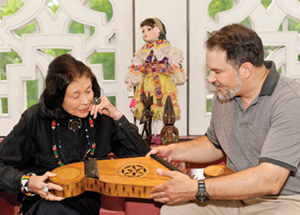Unveiling Treasure Trove of Nationality Room Artifacts
The wooden figurine, representing femininity and grace, depicts an Indonesian woman wearing a formal headdress and traditional attire, her hands clasped at her chest. Nearby sits a sculpture of a sankofa bird, whose head is turned back toward its tail. Decorated with cut-metal triangles and multicolored beads, the bird symbolizes a West African belief that the past serves as a guide to the future.

These are just two items in a collection of thousands of artifacts that have been acquired during the 90-year history of Pitt’s Nationality Rooms and Intercultural Exchange Programs. The University is taking steps to give this unique compilation a digital presence, making the items more accessible and visible for public appreciation.
The Nationality Classrooms recently launched Artifacts of the Nationality Rooms, a website with photos and brief descriptions of the items and their significance and origins: tinyurl.com/pitt-artifacts. Future plans include installing museum-quality display cases on the Cathedral’s third floor, beginning in 2017.
E. Maxine Bruhns, director of the Nationality Rooms and Intercultural Exchange Programs, said Pitt’s efforts will further showcase the richness of Southwestern Pennsylvania’s ethnic heritages. During her 51 years as program director, Bruhns has overseen the creation of 11 of the 30 Nationality Classrooms, all located on the Cathedral of Learning’s first and third floors.
“Many of these items have been passed down through familial generations. Some are priceless in their monetary value while others are invaluable in sentimentality. We treasure them all as symbols of the cultures that came together and worked to shape our region,” said Bruhns. “The Nationality Classrooms have been fortunate to have a large community of well-wishers who have entrusted their personal heirlooms to our care. It is our honor and privilege to give these artifacts wide exposure within the University and broader Pittsburgh community.”
In addition to the artifacts’ aesthetic beauty, each item offers a story of educational value, says Nationality Rooms Tour Coordinator Michael Walter.
Walter pointed to the Yoruba Double Priest’s Shawl, a finely decorated garment with circular flaps along each side. The shawl was worn over the shoulders of Yoruban priests during public appearances in what is now Nigeria, Benin, and Togo.
Walter then held up an elaborately detailed doll from Slovakia’s Jablonica region. Dressed in red shoes, white stockings, and a colorful dress with floral embroidery, the doll has been used as an example to teach Pitt’s Quo Vadis Guides—Nationality Rooms student tour guides—about traditional Slovakian dress.
Secured in a storage area in the Cathedral’s basement, some of the artifacts have been in the University’s possession since the early 1930s. Walter has been archiving the items since arriving at Pitt in 2006.
The Artifacts of the Nationality Rooms website was constructed by a small group of Pitt staffers and volunteers. Walter plans to continue the site’s development, adding additional artifact photos and more complete descriptions and explanations of their origins.
“We’ve done a great deal, and we look forward to doing so much more. We’ve literally only scratched the surface of exploring what we have in our possession,” Walter said. “This is an exciting historical endeavor that will benefit the University and the City of Pittsburgh.”
Other Stories From This Issue
On the Freedom Road

Follow a group of Pitt students on the Returning to the Roots of Civil Rights bus tour, a nine-day, 2,300-mile journey crisscrossing five states.
Day 1: The Awakening
Day 2: Deep Impressions
Day 3: Music, Montgomery, and More
Day 4: Looking Back, Looking Forward
Day 5: Learning to Remember
Day 6: The Mountaintop
Day 7: Slavery and Beyond
Day 8: Lessons to Bring Home
Day 9: Final Lessons

